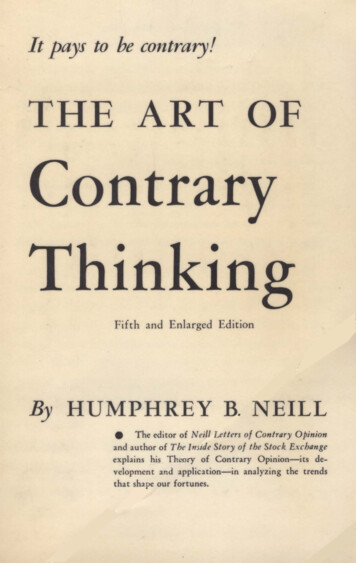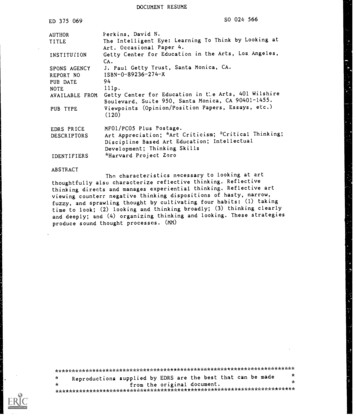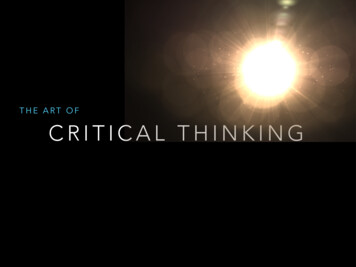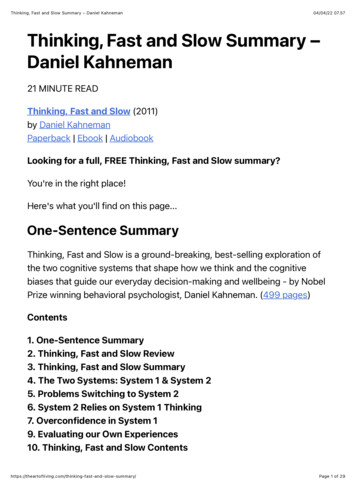
Transcription
It pays to be contrary!THE A RT OFContraryThinkingFifth and Enlarged EditionBy HUMPHREY B. NEILL The editor of N eill Let t ers of Contrary Opinionand author of T he Inside Story of the Stock. Ex changeexpla ins his Theory of Contrary Opinion-its development and application-in analyzing the trendsthat sha pe our fortunes.
4.95"When everybody thinlu tJ,ike,Everyone is likely to be wrong."The ten words quoted above are, according to Humphrey B.Neill, a potent factor behind the economic booms and buststhat blight our civilization. "The Mississippi Bubble," Holland'sincredible "Tulipmania," and the New York stock marketcrash in 1929 are historic examples of disasters magnified andhastened by the pressure of mass opinion.In exactly the opposite direction, in the years immediatelyfollowing the close of W orId War II, ominous popular forecasts of business recession turned out to be wrong. Whatactually happened was-a business boom, not a business bust!The reason is no mystery to anyone versed in the contraryway0/ thought-the practical application ofthe Neill Theoryof Contrary Opinion. Today, this Theory-which began asone man's quest for a way to solve the puzzles of economictrends-has expanded enormously in both scope and significance. Subscribers to Humphrey Neill's Letters already knowhow Contrary Opinion applies to more than just businesstrends. The Letters are now in their fourteenth year of biweekly publication.In THE ART OF CONTRARY THINKING you will findthe answer to a question increasingly asked by persons of affairsand influence: Contrary Opinion-what is it? . What willit do for me?
TIlE ART OF CONTRARY THINKING
BY THE SAME AUTHORT.p, R,.diflg ."d M.,k,t Tectic« (New York: Forbes Publishing Company,19J1). Reprints from Fraser Publi.hing Co., Well., Vt.The Macmillan Company,1939).Fo,ty-,ight Mil/imt Horse) (Electrical Indusrry) (Philadelphia: ]. B. Lippincott Company, 1940).Th, I",id, Story of tb« NNII York S/ock e"ch."gt (New York: B. C.Forbes lli: SonJI Publishing Co., Inc., May, I9S0).II P.yl To Bt Cort/,.,y (a pamphlet, 19J1, which becomes a part of theprescot volume).U.,Jtrst."Jmg Am"Ic"" B."i",ss (New Yo,k:Ntill ull". of Co"I,.,y OPI"lcm.Freier-Neill Letters of Co"t,.,y OPi"iofl, WeIll, Yr.
THE ART OFContrary ThinkingbyHUMPHREYB.NEILL(The Vermont Ruminator)It Pays To Be ContraryFIFTH AND ENLARGED EDITIONTHE CAXTON PRINTERS,CALDWELL, IDAHO1985LTD.
Fim printing, January 1954Second printing, March 1956Third prinring, January 1%0Fourth printing, July 196. Fifrh printing, Augusc 1967Sixrh printing, September 1971Seventh printing, December 1976Eighrh printing, July 1980Ninth printing, August 1985COPYRIGHT 1954, 1956, 1%0 AND 1963 BYTHE CAXTON PRINTERS, LTD.CALDWELL, IDAHOPrinted and bound in the United States of America
To Contrarians and Libertarianseverywhere. May their numbersgrow!
TABLE OF CONTENTSTHE ART OF CONTRARY THINKINGBEFORESECTIONYouBEGIN-I-IT PAYS TO BE CONTRARYSECTION II-EssAYS PERTAINING TO THETHEORY OF CONTRARY OPINION AND THE ART OF CONTRARY THINKINGWaves of Mass SentimentThe Investors' Dilemma . .HabitThe Psychology of InflationWhen There Is No Public OpinionImitation of the Minority For Your Notebook On Being Contrary to the Gregarious OpinionThe Theory of Contrary Opinion Is a "Way ofThinking" . .Thinking By AccidentPut the Cart Before the HorseLaw of Universal Inequality .PropagandaRealism: The Contrary Challenge of the New YearHow Economists Sometimes Make Their Predictions Go Wrong . . . Ask "What's Right?"-Instead of Always"What's Wrong?". . . Mass Psychology and the CampaignsSocial Psychology. . . . 1349J1J3HJ76062646667697174767880828486
viiiTABLE OF CONTENTSPtlgeEconomic PsychologyLooking BackAn Historic Return to Gold Contrary Events from HistoryTidal Movements.Much to L e a r n .On Predicting the Unpredictable"Crowd Upset" Favors EisenhowerMoney Minds Why Forecasts Go HaywireRevolutions Require the Long ViewTheory of Contrary Opinion Hinges on Laws ofImitation and Contagion. Where Will Mass Confonnity Lead?The Theory of Contrary Opinion Deals withDelusions and Mass MisconceptionsLooking Two Ways at OnceThe Ticklish Business of ForecastingWhat's the Usc of It All?Maybe Some Old Theories Are Still Valid"Neutralism"-in Economic WritingBe a Nonconformist in Your ThinkingMore on Socio-political TrendsThinking Humanistically As Well As RealisticallyThinking in Circles " . Still Doesn't Know What Makes Him Tick"Three Types of "Opinions"-Thoughtful, Thoughtless, EmotionalHow Opinions Are FonnedRead-and-Needle Is the Contrary WayThe Theory of Contrary Opinion and the "TriadicLaw" "Social Pressure Often Breeds Conformity" MomentumMore on the Contrary Approach to Creative 012212312612800021H136137140142144146148
TABLE OF CONTENTSMotives and Movements. . .,Mass Mesmerism. . . . Again on the Question: "Is the Public AlwaysWrong in the Market?". . . The Problem of Knowing and Measuring OpinionsThe Law of Mental Unity of Crowds . . The Theory of C. O. Is Not a System of Forecasting:It Is a Method of Working Toward Thought-OutConclusions . . . "Why Do You Think You Think?"Let Us Be Contrary: Let Us Not Deny That OurDestiny Lies in the Skies . . .Capitalism's Basic Factor: Earning PowerA Libertarian Surely Has To Be a Contrarian TheseDays! . .A Fallacy in Economic Extrapolation . . . . .How To Look Ahead-ProfitablyIs There Any Real Purpose in Contrary Thinking?Limbering Up Your Mind. . . . A Money-Mind Versus the Impetuous Impulse ToMake Some Easy Money . Communists Practice the Theory of C.O.The Right Word (or Thought) May Be Worth aThousand Pictures . . .A Think-It-Out-For-Yourself KitOpinions and Words Versus FactsThe Years Forecasters Would Like to ForgetQuick to Conform, but Slow to DifferForty-One Years of "Unexpected" EventsEpilogue: Slaves to "They," by Samuel B. PettengillixPage1491 2IJ41 61 716016216316 16716817017217411 177179182184186188190193
THE ART OF CONTRARY THINKINGTHE ART OF contrary thinking may be statedsimply: Thrust your thoughts out of the rut. In aword, be a noncomformist when using your mind.Sameness of thinlUng is a natural attribute. So youmust expect to practice a little in order to get intothe habit of throwing your mind into directionswhich are opposite to the obvious.Obvious thinking-c-or thinking the same way inwhich everyone else is thinking-eommonly leads towrong judgments and wrong conclusions.Let me give you an easily remembered epigram tosum up this thought: .When everyone thinks alike, everyone islikely to be wrong.In order to stimulate your interest in the subjectof this pamphlet-namely, the art of contrary thinking-let me offer this second thought: If you wishto keep from guessing wrong, learn to think contrarily.In the pages that follow you will find in the firstsection (titled "It Pays to Be Contrary") a runningstory of the Theory of Contrary Opinion. In thesecond section you will find a series of brief essayscovering ideas pertinent to contrary thinking.In presenting the subject in this manner I thinkyou will find it broken down in such fashion that it
2THE ART OF CONTRARY THINKINGis not only easily reviewed but also, I hope, somewhatentertaining to read.From long study of mass movements and publicpsychology there is no question in this writer's mindthat if one trains his mind to think opposite to theherd he will be right more often than wrong. Inother words, concerning most subjects it is prettysafe to say that "the crowd is usually wrong"-atleast, in its timing of events.Please do not misunderstand the saying "the crowdis wrong." I do not mean that people are wrong intheir philosophies concerning their everyday living.What I refer to is this: When masses of people succumb to an idea, they often run off at a tangent because of their emotions. When people stop to thinkthings through, they are very sane in their decisions.It is when some occurrence arises that has wide emotional appeal that you find "the crowd going wrong."You perceive the significant difference, I'm sure. Inone case people act as "a crowd" and in the other asindividuals.History books relate countless manias that reflectthe peculiarities of crowd-action. Several of thesewill be referred to in the following pages.You will find that most of the references and discussions in this pamphlet have to do with economicand financial subjects. However. the reader shouldbe reminded that the art of contrary thinking isapplicable to almost any subject. It is applicable toarguments in philosophy and frequently applicableto politics. In politics, obviously. those who are running for office are after the popular vote. Candi-
THE ART OF CONTRARY THINKING3dates who are skilled in the use of crowd psychologywill call into play all of the various tricks whicharouse people's emotions and desires.What it comes down to in the final analysis isthat a "crowd" thinks with its heart (that is, is influenced by emotions) while an individual thinkswith his brain. This is no reflection on any individualbecause, when any of us are grouped in a crowd, weare likely to lose our balance, you might say; webecome one of a group rather than remain as anindividual. You've often heard it said that so-andso "lost his head"--or that "his heart ran away withhis head."This writer believes the great lack in economic andpolitical studies is the failure to analyze human nature.How people think and how they act are too oftenoverlooked when we are trying to project a futurepattern. Human behavior is fully as important as,if not more important than, statistical behavior. Ibelieve that the human figure, in other words, isfully as important as the mathematical figure in ourcalculations concerning economic trends and sociopolitical trends.Over the past thirty years we have had whatamounts to a complete social revolution.' Peoplethink differently today from the way they did, say,prior to 1929; that is, prior to the Great Depressionand the New Deal. When you stop to think of themillions of young people whose judgments and perspectives in life have actually been formed since the1 See Garet Garrett', Th, PtOPU'J PolI.g,. and other Libertarian book.,published by The Caxten PriDter., Ltd.
4THE ART OF CONTRARY THINKINGadvent of the New Deal-the advent of the socialrevolution-you see at once how differently one hasto look at questions today from the way he wouldhave looked at them in former times.While this writer is fond of reading and studyinghistory, nevertheless, when reading history, one hasto adapt his thinking to modern interpretations. Itis said, you know, that "history repeats.' This is anaccurate saying, but you will find that whereas history does often repeat, it never seems to repeat inexactly the same manner or in the same fashion.One can learn a vast amount concerning the subject of mob psychology by studying past manias andpast episodes, but in each case it is important to analyze the impetus which motivated the particularmania, or the fad which overtook people at a giventime.For example, one would not expect another landboom and mania in Florida with characteristics similarto the land boom which occurred in Florida in themid-twenties.Another example from more recent times wouldbe the successful political campaign which formerPresident Harry S. Truman conducted in the fall of1948. At that particular time his tactics and hisstrategy-all of which, by the way, were in full accord with the principles of mob psychology-thosetactics probably would not work again in just thesame manner. Indeed, when he went out to supportthe Democratic candidate in 1952, Mr. Truman's similar strategy was unsuccessful. Many observers feltthat Mr. Stevenson, for example, might have had a
THE ART OF CONTRARY THINKINGfbetter chance in 1952 if Mr. Truman had not tried torepeat his tactics of 1948. I am simply passing thisalong as an illustration of how the appeal to the crowdmay work at one time, whereas at another it willhave an entirely different result.To bring this introduction down to a conclusion,let me repeat:The art of contrary thinking consists intraining your mind to ruminate in directions opposite to general public opinions;but weigh your conclusions in the light ofcurrent events and current manifestationsof human behavior.It may appear to some readers as though the theoryof contrary opinion, or the art of contrary thinking,is a cynical one. I do not think it is at all. I believeit is merely a matter of getting into the habit oflooking on both sides of all questions and then determining from your two-sided thinking which isthe more likely to be the correct version-which inturn leads to the correct conclusion.Finally, let me emphasize here the factor of propaganda. We are mentally swamped today with allforms of propaganda. It pours out in millions ofwords. Obviously, propaganda is for the purpose ofinfluencing minds. Therefore, it is essential to lookupon both sides of public and economic questions inorder to avoid being entrapped by the propagandists.HUMPHREYSaxtons River, VermontB. NEILL
THE ART OF CONTRARY THINKING
BEFORE YOU BEGINHere's a brief summary of the theory of contraryopinion, from which the art of contrary thinking isdeveloped.FOR A quick look, and to become acquainted withthe theme of contrary thinking, prior to reading whatfollows, this brief summary is presented; it is ananswer in as few words as possible to the question:"What is the Theory of Contrary opinion?"1. Primarily, it is a method of ruminating over a broad rangeof public questions; political, economic, and social. The objectof contrary thinking is to challenge generally accepted viewpointson the prevailing trends in politics and socio-economics. In sum,the purpose is to contest the popular view, because popularopinions are so frequently found to be untimely, misled (bypropaganda), or plainly wrong.a. Experience with contrary thinking warrants the use of suchsloganized expressions as these:When everyone thinks alike, "everyone" is likely to bewrongWhen writers write alike, readers are prone tothink alikeToo many predictions spoil the forecasts;or, to put it another way, the weight of predictions causestheir own downfall. (What happens is that counteractingpolicies are adopted to offset, or by-pass the "expectancy.")b. Caution: The contrary theory is a way of thinking, butlet's not overweigh it. It is more of an antidote to generalforecasting than a system lor forecasting. In a word, it isa thinking tool, not a crystal ball. It forces one to thinkthrough a given subject. As has been said: If you don'tthink things through, you're through thinking.
10THE ART OF CONTRARY THINKING2. Human traits that make the theory of contrary opinionworkable, -OpinionWishful ThinkingImpulsivenessConceit3. The theory is based upon "laws" of sociology and psychology, among which these are logically related:a. A "crowd" yields to instincts which an individual actingalone represses.b. People are gregarious; instinctively they follow the impulses of the "herd."c. Contagion and imitation of the minority (follow-theleader) make peoplesusceptible to suggestion, to commands,to customs, to emotional 11IOtivfltion.d. A crowd never reasons, but follows its emotions; it acceptswithout proof what is "suggested" or "asserted."Now, for an equally brief survey of some uses andexamples of Contrary Thinking:1. Let me start out with a socio-political thought, as it maysuggest a broader application than some reference to, say, acrowd stampede in the stock market.a. You will agree, I think, that socialism is kin to communism.b. Yet, millions of people (an immense "crowd") who aresocialistically inclined believe they are anticommunistic.They delude themselves. No greater (or more r.ienacing]delusion prevails. Socialism leads to communism. To rootout communism it is essential to weed out socialism. This,admittedly, is a herculean t:1sk-one unlikely to be accomplished in our lifetime.The foregoing is an example of approaching aproblem hind-end-to: the contrary approach. In allpublic questions which engage people's minds the
THE ART OF CONTRARY THINKING11contrarian tries to see in behind the surface opinions(as above, that people fail to recognize the kinshipbetween the two isms).2. Consider the contrary questioning of propaganda whichis so prevalent today.a. It is the reasons behind, not the mere words in speeches,pronouncements, and articles which we have to seek. Whyis the message circulated?-not simply what is in the message. Quite frankly, the contrarian needs to be cynical inthis propaganda analysis, but so long as "opinion-makers"are out to sway and mold public opinion the only defense is"to doubt all before you believe anything"-and to lookbehind the words for meanings.3. Manias and waves of mass sentiment-and crowd beliefssweep across nations when least expected. And they change justas swiftly. History is full of stories of tulip manias, South Seabubbles, Florida land booms, and Ponzi schemes.a. More concretely, these examples might be mentioned, whena contrary view would have been the correct one to hold:That (in 1929) we reached a New Era and a new plateauof permanent prosperity . . That (in the 1930's) we hadreached economic maturity. That (in the 1920's) radiowould put the record player and records out of business forall time. That (currently) television will kill off themovies. (The contrary view here is that people are gregarious-like to go out and mingle with the crowd. Publicentertainment is as old as history and it is a safe contraryopinion that human nature has not changed. Solitary entertainment will never satisfy the masses. In the long runtelevision will enlarge the audiences, will create greaterentertainment demands.) We might add one moreexample--that of 194 f, when it was widely predicted thatan immediate postwar slump would find eight million outof work.You will see, if you pursue the subject, that acquiring the art of contrary thinking is a fascinating study.The following pages leave ample scope for adding yourown thoughts to those of the author's.
SECTIONIIT PAYS TO BE CONTRARY"As a general rule, it is foolish to do justwhat other people are doing, because thereare almost sure to be too many people doingthe same thing."-WILUAM STANLEY lEVONS(183f-1882)
IT PAYS TO BE CONTRARYSTIMULATED by the reference in Life/ there hasbeen a growing and serious interest in the "Theoryof Contrary Opinion." Considerable curiosity hasbeen aroused concerning the art and usefulness ofcontrary thinking in appraising economic and sociopolitical trends.The purpose of this section, therefore, is twofold:1. To reply rather extensively to the numerous inquiries received that ask: "What;s this Theory of Contrary Opinion?"2. To attempt to explain the usefulness of contrary thinkingand to show that "it pays to be contrary."You will have to forgive the author if he makesgenerous use of the vertical pronoun because muchof what follows is personal history.The Theory of Contrary Opinion is not somethingthat one reads about in books or histories. There isno literature on the subject. Nothing has been written directly on the use of contrary opinions that Iam aware of, except an excellent chapter pertainingto "contrary market opinions" in a book on stockmarket methods," In this book the author kindlyrefers to my writings as being the reason for includingthe discussion in his book. )'Ufe, Much 21, 1949, wherein appeared comment that this writer "formulated the Theory of Contury Opinion." following which quoution' fr(lm 194' contrary opinion were given. See "The Strange State of the Market,"by Willi3m Miller.I Ntw MtthoJ, lor Profit in Iht Stock Marktt, by Garfield A. Drew(Bestem The Metcalf Pre., 19J1, and lub,equent editions}, An euellenttreatise on technical method,.
16THE ART OF CONTRARY 'flUNKiNGThus this report on a "contrary" method of analyzing economic trends. I have written many thousands of words of contrary opinion in my formernewspaper columns ("The Ruminator") and in ourpresently published Neill Letters of Contrary Opinion. Here I put my thoughts and writings togetherin one volume.With this prior word let us look into the subject.IGoethe, the great poet-philosopher, oncewrote: ttl find more and more that it is wellto be on the side of the minority, since itis always the more intelligent."Quite frankly, the urge that first sent me on aquest that ended in the Theory of Contrary Opinionwas the disappointments and disillusionment thatcome to everyone who seeks a method "to beat thestock market."My acquaintanceship with Wall Street dates backinto the ill-fated 1920's. I soon heard about thehundred and one technical systems then in vogue forpredicting the swings in stock prices. Losses in marketoperations quickly revealed that it isn't the systembut the trader or investor himself who is at fault.Take many chart-reading ideas, as an example. Onecan interpret charts almost any way he wishes. Hecan read into their "formations" just about any probable result he hopes for. Which is to say, that if one
THE ART OF CONTRARY nUNKING17is bullish at heart his chart reading is likely to beinterpreted optimistically; if bearishly inclined, chartsaccommodatingly will "say" that the market is goingdown. During one-way market trends (whether upor down) the trends are clearly enough defined on thecharts; but when the market comes to an impasseand everybody is in a quandary as to the directionprices are likely to go, then the charts, too, are usuallyUsilent."On numerous occasions in the past 1 recall technicalstudents of the market arguing about the probablecoming trends and almost without exception eachperson would interpret "technical action" in accordance with his deep-seated personal opinions. Inother words, the enemy of speculative success-wishful thinking-usually made the decisions.With all respect for proponents of technical market-analysis methods, I doubt very much if any socalled "technical method" will ever completely enablepeople to overcome their inherent traits of hope,greed, pride-of-opinion, and similar human failingsthat make successful speculation one of the mostdifficult arts to master. (I might inject that "technical methods" refer to trend forecasts made up onthe basis of the market's action in both volume andprices as well as other data.)So it was that 1 soon learned (the hard way) thatnot only were individual opinions frequently wrongbut that my own judgment was often unprofitablyfaulty.Accordingly, 1 turned to a study of mass psychology in the hope of finding the answer to the
18THE ART OF CONTRARY THINKINGriddle of "why the public is so often wrong" (andthat meant why I was so often wrong). I dug intoold books on the manias of speculation; I read everything I could get my hands on that pertained to theactions of crowds.Also, my work gave me an opportunity to writeon this subject of "human nature in finance" which,of course, was most instructive. There is nothingmore helpful, if you wish to learn about any subject,than to write on it as well as to study it. For twoor three years I wrote a little monthly house organtitled 1/, As and When,s containing brief essays onhuman foibles as they appeared in finance. The"Market Philosopher" and the "Market Cynic" weretwo chaps who discussed the market and economicaffairs in the little magazine. Perhaps you will beamused at what my mouthpiece, The Market Cynic,wrote when things were black in late 1930:TEN WAYS TO LOSE MONEY IN WALL STREETbyThe Market CynicAfter many hours of toil and deep thought I have compiled adependable guide for stock traders. I shall not attempt to explainor qualify these precepts, realizing that my readers will doubtlessfollow them regardless of any advice to the contrary.1. Put your trust in board-room gossip.2. Believe everything you hear, especially tips.3. If you don't know, guess.4. Follow the public.s. Be impatient.6. Greedily hang on for the top eighth. Thi! led to the authorship in 19)1 of Tap R atlj"g a"tI M.rktt Tactics(recently reprinted by Fnaser Publishing Co., Wells, Vt.). which Includesabout IS much discussion of human action al of market action.
THE ART OF CONTRARY THINKING7.8.9.10.19Trade on thin margins.Hold to your opinion, right or wrong.Never stay out of the market.Accept small profits and large losses.As an antidote to reckless trading or investinghabits, wemight insert here the admonition of RussellSage who, when asked how he founded his fortune,replied: "By buying straw hats in January."As my interest in the human side of speculationdeveloped I also found that studies of crowd behaviorwere singularly helpful in interpreting other, farbroader, economic forces than merely fluctuationsin stock prices. Not to bore you further with personal reminiscences, let me sum up my experiences:First, as mentioned, I learned that individual opinions (my own as well as the nextman's) are of little value-because so frequently wrong.Second, that human traits (of fear, hope,greed, pride-of-opinion, wishful thinking)are so strong in the human breast that theyprevent one from being objective. Objective analysis of economic trends is imperative, I believe, as subjective reasoning leadsto opinionated conclusions.Third, that if one relies stubbornly onhis own opinion he is likely to "stand onhis opinion," right or wrong. No trait isstronger, perhaps, than that of defendingone's opinion and of being unwilling toadmit error in judgment.
20THE ART OF CONTRARY TIiINKINGWith these basic human equations to deal with,the next problem was to find a solution.Early in my studies and writing I had uncoveredthe age-old truism, mentioned above, that tithe crowdis usually wrong." History is replete with examples,a few of which we shall touch upon soon.It was through a natural evolution, therefore, thatI found what I think is a usable solution:If individual opinions are unreliable, whynot go opposite to crowd opinion-that is,contrary to general opinions which are sooften wrong?And that is how the Theory of Contrary Opinionbecame a favorite subject to which I have since devoted countless hours and numberless words! Thatis my excuse for venturing to offer THE ART OFCONTRARY THINKING.Let me emphasize that "contrary opinions" areof great value in analyzing economic and politicaltrends, not merely to catch an occasional swing inthe stock market. Market trends are symptomaticof fundamental shifts in our economy and in theworld economy. In this regard they are significant,of course, but the lesser ups and downs in stock pricesare of negative value and are generally unpredictable.IIAdmittedly, it is possible to err in gauging the contrary opinion. You often will, no doubt. I found
THE ART OF CONTRARY THINKING21in my own case that it took several years, as a matterof fact, before I was able to weigh "public opinion"with sufficient accuracy to feel reasonably confidentof the contrary conclusion. It takes time to form thehabit of thinking contrarily.Moreover, even with contrary opinions as a guidewe still have to fight against personal viewpoints.For example, if you feel strongly about a certaineconomic situation it is difficult oftentimes to submerge your feelings and coldly gauge public opinion.So, occasionally you will misjudge public opinionbecause of your preconceived opinions. You willjump to the conclusion that the public opinion isas you wish it were, and thus, unconsciously, youbecome a member of the "public" and in realitythink as the public does.However, after getting into the habit of "thinkingopposite" you will less frequently be subject to theold traits. Finally, you may become completely objective and become the boss over those natural humanfailings. When that time arrives you will be amazedat how often you are right when (and because) othersare wrong! A skeptical undertaking, isn't it? Butit pays in the long run.This is the only method I have uncovered in twentyyears of searching that enables one to submerge thehuman traits that are the enemies of clear thinking.You cannot be "opposite" to the general viewpoint(which, admittedly, will appear to be the more logical) and at the same time listen to the misleadingvoice of "hope" and "pride-of-opinion."
22THE ART OF CONTRARY THINKINGNow you may be asking yourself, "How do I goabout finding out what the public opinion is?"I grant you that you will have to peruse a pile ofnews and comments. However, our radios, newspapers, and magazines unload such a flood of economic news and propaganda these days, it is not difficult to get a fairly accurate cross section of whatpeople probably are thinking about and what thecomposite opinion is likely to be. Also-and this isimportant-of what some groups want us to acceptand believe.A 1946 act of Congress established the CEA-thepresident's Council of Economic Advisers. Since thattime there has been a vastly greater outpouring ofeconomic news and comments-and opinions-thanbefore. Because the CEA viewpoints are official, theyhave tremendous influence upon public opinion.'Official "economic releases" are especially important to analyze and weigh for their effect on thepublic. By the way, when we speak of "the public"it includes businessmen, too. Do not think that thepublic is simply the people hanging around streetcorners. The public is everybody, including you andme. A consensus of businessmen-or brokers- or anygroup-is valuable in making an analysis of opinions"to be opposite to" because of their influence ongeneral sentiment. The ellA, under President Eisenhower, may not publicly air in viewsoften as under Pruident Truman, but it wil\ be influential on opinions(e.pecially businessmeo's opinions) nevertheless. Several of
way 0/thought-thepractical application of the Neill Theory of Contrary Opinion. Today, this Theory-which began as one man's quest for a way to solve the puzzles of economic trends-hasexpanded enormously in both scope and signifi cance. Subscribers to Humphrey Neill's Letters already know ho










